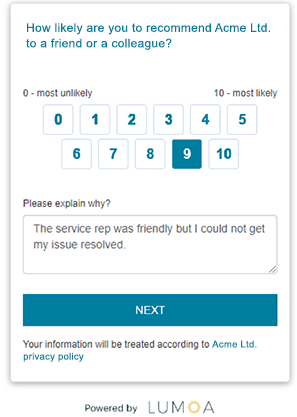Average Survey Response Rate You Should Aim For

Last updated on August 22, 2023
Setting survey response rate benchmarks can help you assess the performance and overall growth of your customer experience management (CEM) system. While benchmarking is a common process in many companies, the exact steps and data collected need to be adjusted to each organization’s requirements.
If this process isn’t tailored to your company, you’ll set inaccurate survey response rate benchmarks and compromise all future evaluations. To avoid this, you need to understand how these benchmarks work, research average survey response rates in your industry, and create an organized strategy.
In this article, we’ll define internal and external benchmarks. We’ll also share the areas of your CEM system you can record and provide general steps to help you benchmark your performance.
What Is Your Survey Response Benchmark?
In order to fully grasp this process, it’s important to understand the definitions of survey response rate and benchmarking separately.
Survey response rates refer to the percentage of customers that reply to your surveys versus the number of potential respondents. This statistic includes positive as well as negative interactions and creates an average rate that’s expressed as a percentage.
Benchmarking, in the general sense, is the process of documenting a company’s performance during any given period with the goal of comparing it to another period, often in the future. The concept of benchmarking can be as broad or as granular as required. This means that it can be applied to specific process flow or entire departments alike.
As you may have deduced already, the survey response rate benchmarking process consists of documenting the performance of your CEM system. The idea is to record your current performance and the processes in place. Then, make improvements and assess the impact of these adjustments by measuring the future performance against the prior benchmark.
While benchmarking can be applied to a wide range of activities, this process can either be categorized as internal or external.
Internal benchmarks
The internal benchmarking process allows you to see how your current performance measures up to the past as well as future production of your own company. This can help you determine how much your company has grown over specific periods of time.
Keep in mind that this process measures the same statistics as its external counterpart. The difference is that, as long as your benchmarking process is sound, the results you get should be exact. The reason for this is that you have all your performance metrics readily available, which allows you to perform specific calculations.
External Benchmarks
The main challenge with external benchmarks is that you need to collect data from the main competitors in your industry.
Since most enterprises don’t disclose detailed reports on their internal statistics, collecting external data is often challenging. For this reason, the values collected need to be treated as estimates rather than concrete statistics.
Nevertheless, the external benchmarking process provides insights and holds immense value, whether it’s performed by growing businesses or established enterprises.
Types of Customer Service and Experience Surveys
Creating an effective CEM system is crucial, but the first step is collecting enough survey responses to create a benchmark.
A corporate marketing and research teams have spent decades collecting information from consumers via surveys.
However, customer experience surveys have evolved a lot since their verbal and print forms, which means that companies can now leverage a wide range of techniques to collect data. Here are the main types of customer service and experience surveys that you can benchmark.
Net Promoter Score (NPS)
Net Promoter Score surveys first emerged in 2003 and they are a simple, yet effective way to assess your customers’ collective sentiment. It consists of asking customers one question: how likely are you to recommend this product/service to a peer or colleague?
NPS surveys can also include optional questions for customers to answer after providing the first response. If you want to know the typical survey response rate for NPS surveys for your type of company, industry-specific reports are always a great place to start.

Customer Satisfaction Score (CSAT)
Perhaps the most common type of survey in the customer service industry, CSAT evaluations ask customers to rate their satisfaction on a 1 to 5 or 1 to 10 scale, with the highest value meaning completely satisfied.
Benchmarking CSAT surveys is simple, unless you switch your rating scale. In this case, you may have to adjust the previous values to maintain the data’s integrity.
Customer Effort Score (CES)
Customer effort score or CES evaluations attempt to measure how much effort customers had to go through to complete a specific action. It’s usually used to measure the performance of customer service or customer success teams. That said, it can also be used for complex conversion flows and similar instances.
As with CSAT, CES surveys can be difficult to benchmark if you change the questions being asked, so make sure to account for this discrepancy when creating your benchmarking process.

Visual rating
Visual rating surveys are another type of evaluation that can be recorded but can also change over time. If your CEM system employs this time of feedback collection, verify that it has remained standard or create a method to standardize feedback across all formats.
Custom or Free-Response Format
Custom or free-response formats ask customers open-ended questions. However, the unique process of learning how to create customer surveys and their unstandardized nature make them difficult to track. In these cases, you may need to leverage a next-generation customer insights platform that provides actionable data, like Lumoa.
Note that free-response surveys include a wide range of evaluations, including:
- Product or service development
- Post-purchase or point-of-conversion
- Usability questionnaires
If you want to learn more about customer experience metrics and KPIs, check out this article: 6 Most Popular Customer Experience Metrics and KPIs Explained Simply.
Customer Survey Response Benchmark Estimations
If you’re setting survey response benchmarks for your different customer survey channels, you’ll probably see a huge discrepancy between the values of each channel.
Our observations show that the average response rate across all channels and industries stands between 17% and 20%.
However, remember that different target audiences have distinct behavioral patterns. This means that you have to set a benchmark for each channel and industry.
Survey Response Benchmarks for different types of surveys
| NPS Survey Average Response Rate | 18% |
| CSAT Survey Average Response Rate | 14% |
| CES Survey Average Response Rate | 29% |
| Visual Rating Survey Average Response Rate | 22% |
| Custom Format Survey Average Response Rate | 10% |
Remember, the values above are estimates based on our internal and external research. This data may be used as general benchmark values, but you can also conduct industry-specific research to get more accurate results for your organization.
How to Set Your CEM Survey Response Benchmarks
Every organization is different, so there is no “one-size-fits-all” method to set benchmarks for your company.
You’ll need to determine which feedback collection channels you currently have open, ensure that you have enough data available on each one, and create a plan to set individual benchmarks. You should also develop a method to grade the performance of your entire CEM system through a single metric that’s tailored specifically to your company.
If you’re asking yourself “how many survey responses do I need?” the answer is not that simple.
You’ll have to take context into consideration to ensure that you have a statistically-valid survey response rate. For example, call centers that receive thousands of daily interactions will need to collect more data than facilities that handle a much smaller volume.
You can read our article on how to calculate sample size to determine how many interactions you’ll need.
With the above in mind, here are general steps you can adapt and follow to benchmark your CEM system.
Record Your Current Flows and Processes
Many organizations opt for simple benchmarking, where only the performance data is assessed. Instead, you should also document the flows and processes you currently have in place. This includes all documented flows as well as steps that individual agents take to cater to their different clients. This data will help you figure out the impact of the adjustments you implement.
Collect Analytical Data
Once you have described all processes in detail, you can turn your attention to the analytical data. Try to be as granular as possible in order to have a comprehensive view of your CEM system and don’t be afraid to include the exact ratings for each question in every survey format.
If you are performing an external benchmark, you also need to detail your main competitors’ performance. As we mentioned before, limited access to competitor data makes it difficult to have exact values.
To overcome this challenge, most companies compile as much external data as possible and create a set of metrics that represent the entire competition.
Ensure that You Have Comprehensive Performance Data Available
Whether you’re performing internal or external benchmarking, you need to have enough information about your company for the process to be successful.
However, it’s impossible to get a comprehensive view of your performance if you’re not tracking the right metrics.
Besides the number of interactions and potential interactions, you should also document additional details for each channel. For example, if you’re running surveys via email, you should also benchmark metrics like the:
- Amount of time receivers spent without opening an email
- Email click-through rates
- Number of monthly subscribers
Document Your Benchmarks
Now, it’s finally time to start documenting your benchmarks. You should avoid making major changes right before you start benchmarking because they may sway the data. The best alternative in these cases is to measure your current performance and use the benchmarking process to assess how the changes impact your performance.
Benchmarking databases look different in every company. With this in mind, most firms and organizations condense them into reports that are easier to digest by executives.
Organizations that are creating external benchmarks also need to document competitor/industry performance metrics and ensure that this data is included in the reports as well.
Implement Changes and Collect New Performance Data
The last step is to make adjustments based on the benchmarks you already have. You should use these statistics to identify areas of improvement, determine what changes may have a positive effect, and implement these adjustments.
Additionally, you should also create a benchmark and evaluation schedule where you record your current performance and go through the process again.
Looking to Improve Your CEM System? Leverage the Data Collected with Lumoa
Improving your CEM system is an ongoing process and having an accurate benchmarking mechanism will help ensure that you stay on the right track. The general tips above can help ensure that you benchmark the right types of surveys and zero in on metrics that provide actionable insights.
If you want to learn more about Lumoa and how it can help you assess the data you collect through all of your surveys, contact us today or start a free trial.
